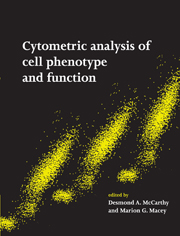Book contents
- Frontmatter
- Contents
- List of contributors
- List of abbreviations
- 1 Principles of flow cytometry
- 2 Introduction to the general principles of sample preparation
- 3 Fluorescence and fluorochromes
- 4 Quality control in flow cytometry
- 5 Data analysis in flow cytometry
- 6 Laser scanning cytometry: application to the immunophenotyping of hematological malignancies
- 7 Leukocyte immunobiology
- 8 Immunophenotypic analysis of leukocytes in disease
- 9 Analysis and isolation of minor cell populations
- 10 Cell cycle, DNA and DNA ploidy analysis
- 11 Cell viability, necrosis and apoptosis
- 12 Phagocyte biology and function
- 13 Intracellular measures of signalling pathways
- 14 Cell–cell interactions
- 15 Nucleic acids
- 16 Microbial infections
- 17 Leucocyte cell surface antigens
- 18 Recent and future developments: conclusions
- Appendix
- Index
- Plate section
10 - Cell cycle, DNA and DNA ploidy analysis
Published online by Cambridge University Press: 06 January 2010
- Frontmatter
- Contents
- List of contributors
- List of abbreviations
- 1 Principles of flow cytometry
- 2 Introduction to the general principles of sample preparation
- 3 Fluorescence and fluorochromes
- 4 Quality control in flow cytometry
- 5 Data analysis in flow cytometry
- 6 Laser scanning cytometry: application to the immunophenotyping of hematological malignancies
- 7 Leukocyte immunobiology
- 8 Immunophenotypic analysis of leukocytes in disease
- 9 Analysis and isolation of minor cell populations
- 10 Cell cycle, DNA and DNA ploidy analysis
- 11 Cell viability, necrosis and apoptosis
- 12 Phagocyte biology and function
- 13 Intracellular measures of signalling pathways
- 14 Cell–cell interactions
- 15 Nucleic acids
- 16 Microbial infections
- 17 Leucocyte cell surface antigens
- 18 Recent and future developments: conclusions
- Appendix
- Index
- Plate section
Summary
Introduction
Cells enter the cell cycle from a state of quiescence following mitogenic stimulation, duplicate their genetic information faithfully and distribute it equally to two daughter cells. To achieve this end, a cycling cell passes through a series of tightly regulated cell cycle phases and checkpoints that ensure complete DNA replication occurs before chromosomal segregation and cytokinesis at mitosis.
Successful cell replication requires mitogen-induced cell cycle entry from the quiescent resting stage G0, into the first gap phase G1. If the extracellular mitogenic signals persist, the cell will commit itself to progress further towards cell replication. Alternatively, withdrawal of these signals (e.g. nutrient withdrawal) results in a return to G0. The point of no return for the cell, with respect to commitment to cell cycle progression, is the restriction point, found late in G1. Once this point has been passed, the decision to replicate DNA, and subsequently undergo cell division, has been made already and becomes independent of mitogenic signalling. DNA synthesis then occurs in S phase and on its completion, cells enter the second gap phase, G2, before the initiation of mitosis (M phase). Transition from one cell cycle phase to the next is tightly controlled such that progress to any given phase of the cell cycle will occur only if the previous phase has been completed. The cell cycle machinery ensures that this happens by a series of positive and negative feedback circuits, some of which will be mentioned below.
The cell cycle proceeds via induction of a series of cyclins, which are expressed at the prerequisite stages of the cell cycle.
Information
- Type
- Chapter
- Information
- Cytometric Analysis of Cell Phenotype and Function , pp. 182 - 192Publisher: Cambridge University PressPrint publication year: 2001
Accessibility standard: Unknown
Why this information is here
This section outlines the accessibility features of this content - including support for screen readers, full keyboard navigation and high-contrast display options. This may not be relevant for you.Accessibility Information
- 2
- Cited by
